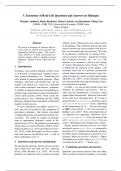A Taxonomy of Real-Life Questions and Answers in Dialogue
Maxime Amblard, Maria Boritchev, Marta Carletti, Lea Dieudonat, Yiting Tsai
LORIA, UMR 7503, Université de Lorraine, CNRS, Inria
Nancy, France
{maxime.amblard, maria.boritchev}@loria.fr
{martacarletti1993, leadieudonat}@gmail.com
yi-ting.tsai5@etu.univ-lorraine.fr
Abstract arbitrary forms following the non-verbal context
of the dialogue. This taxonomy presents the main
We present a taxonomy of questions and an-
types of answers one can encounter in real-life cor-
swers based on real-life data extracted from
spontaneous dialogue corpora. This classifi- pora of transcribed oral conversations. The form
cation allowed us to build a fine-grained an- of an utterance is defined by its syntactic form –
notation schema, which we applied to several such as syntactic inversions – and the lexical items
languages: English, French, Italian and Chi- that it contains (wh-words, ‘yes’, ‘no’, etc.). The
nese. function of an utterance is close to the concept
of Austin’s illocutionary force (Austin, 1975): it
1 Introduction is defined by the intention of the speaker. Our
Nowadays, most spoken dialogue systems focus taxonomy takes root in a previous classification
on task-based communication (making reserva- schema where questions and answers were clas-
tions, getting information, etc.). Annotations are sified according to a mixture of form and function
often limited to domain-specific purposes. Many (Blandón et al., 2019). In this annotation schema
dialogues, especially task-oriented ones, are an- we want to keep the form and the function of ques-
notated with speech acts, which are a powerful tions and answers separate.
tool to detect questions’ and answers’ intentions. In Table 1, we sum up the possible forms and
A tradition of question and answers modelling in- functions for questions and answers. We as-
spired by logic approaches has been introduced by sume that the interpretation of answers’ forms
(Asher and Lascarides, 2003). From a more lin- (upper-right) and questions’ functions (lower-left)
guistic point of view, (Ginzburg and Sag, 2000) do not need to be developed here. If we look at
presents a detailed study of questions coupled with question forms, disjunctive questions can be
insights on their answers. inclusive or exclusive (resp.), depending
As most annotations are highly specific to a on the interpretation of ‘or’ : ‘Do you want sugar
task, they fail to account for the complexity of or milk in your coffee?’ vs ‘Do you want sugar or
spontaneous dialogues. Our schema is designed stevia in your coffee?’. Here, the interpretation of
to handle phenomena encountered in real-life con- ‘or’ depends on its arguments. Questions can be
versations. We worked on corpora of transcrip- auxiliary-deontic (‘Can you hand me the
tions of spontaneous dialogues, mainly in En- salt?’) or auxiliary-epistemic (‘Can you
glish (Norrick, 2017). We produced an annotation swim?’) depending on the auxiliary they contain.
schema that we tested on French (ATILF, 2018), Finally, answers functions can vary a lot. Some
Italian (Sciubba et al., 2014) and Chinese (Univer- are lexical, such as give feature, proposed in
sity, 2015). In this short paper, we focus on ques- Boritchev (2017) (adapted from Jurafsky and Mar-
tions and answers classification (sect. 2) and on tin 2000), which corresponds to an answer to a wh-
their combinations (sect. 3). question (‘Where do you live?’/‘In Paris.’). Others
correspond to an action, such as perform (‘Can
2 Questions and answers classification you hand me the salt?’/‘...’/‘Thank you.’).
We classify the questions and the answers accord-
3 Combining questions and answers
ing to their form and their function, following
(Freed, 1994; Blandón et al., 2019). We do not Questions and answers interact with each other.
pretend to be exhaustive here as answers can take After an analysis of them in isolation, we consider




